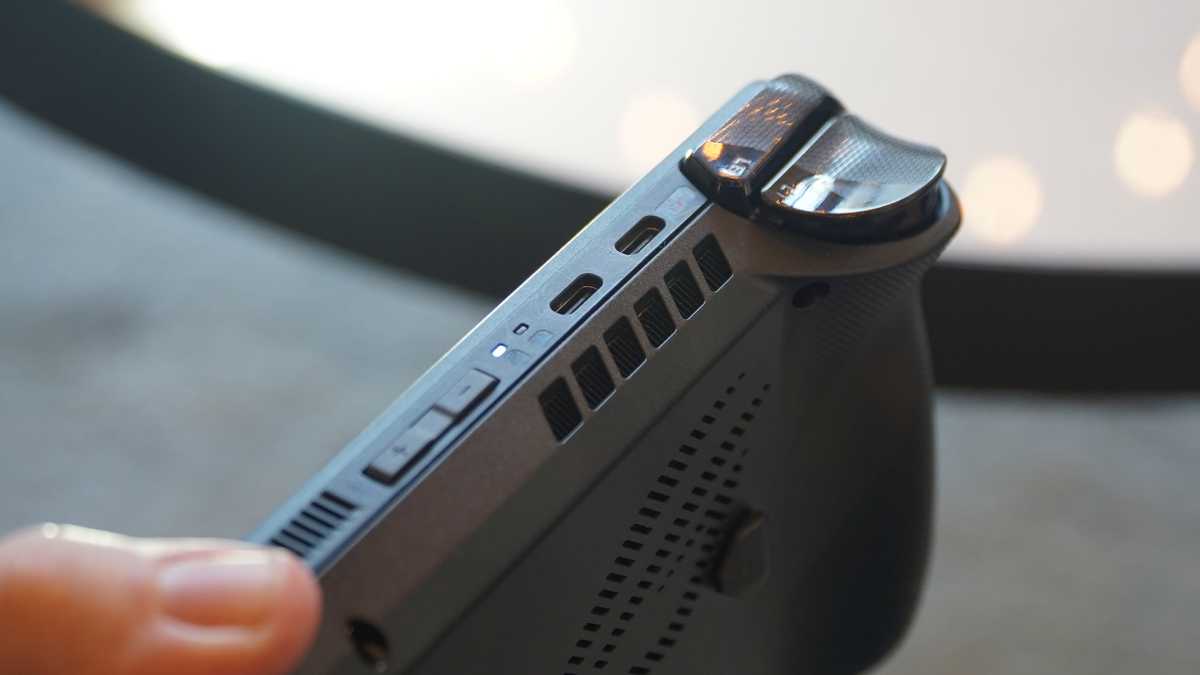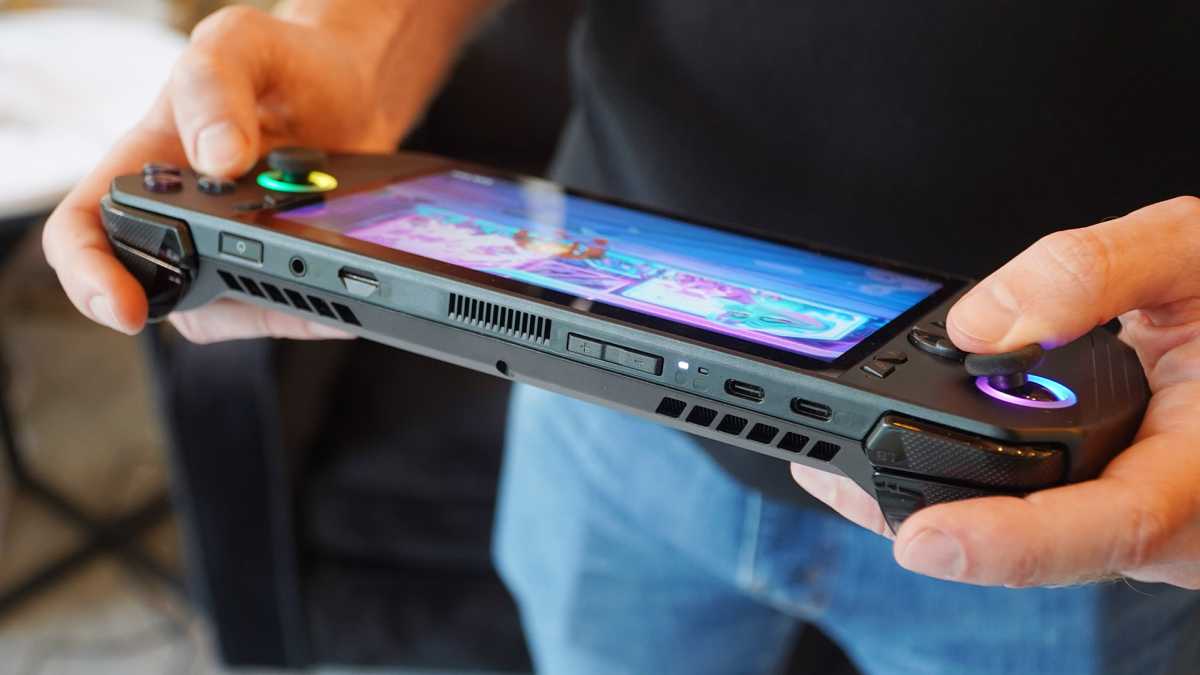When the rumors of the ROG Ally X started coming out, one of the first things they said was that it didn’t replace the Ryzen APU from the original design a year ago. That made me sort of dismissive of the new portable gaming PC…and that was a mistake. The upgrades that Asus has made to this thing are far more than skin-deep.
The Asus ROG Ally X has been redesigned in pretty much every component, with the notable exceptions of the processor and screen. The battery is twice as big. The RAM is boosted by 50 percent. The storage can now accommodate a 2280 M.2 drive — the same size used in desktop motherboards. Even the original’s signature feature, a proprietary connection to an external GPU, is replaced in favor of a more flexible Thunderbolt 4 port that can work with a wider range of extensions.
The chassis of the Ally X is all new, and all black — probably to immediately differentiate it from its white predecessor, which itself was distinctive from the all-black Steam Deck. But remember, the original Ally was the first competitor from a major PC vendor. Now that Lenovo, MSI, and tons of smaller companies like GPD and AyaNeo have Windows-based portable gaming PCs on the market, black feels a little less derivative. While we’re on the subject of style, the new version keeps the RGB lighting around the analog sticks and on a back stripe.
Other changes to the core design are more subtle. Ergonomics have been given a complete overhaul, with the grips and triggers adjusted for better comfort. The new motherboard layout means the two USB-C ports and MicroSD card slot on top have been moved around. Even the angle of the analog sticks, relative to the D-Pad and ABXY buttons respectively, has been adjusted for matter comfort. The whole unit is 4.5mm thicker and 70 grams (2.5 ounces) heavier.
The original Ally, left, and Ally X, right. Note the much larger battery and smaller fans. The new, full-length M.2 drive slot is in the middle.
Michael Crider/Foundry
Most of that is going to the battery, which is the biggest (literally) change in the design. Battery life isn’t great on any portable gaming PC, especially when playing high-end titles, but reviewers and end users were especially unhappy with the Ally in this department. To make improvements Asus full-on doubled the capacity, from 40 watt-hours to 80, which is more than a lot of laptops.
Battery life estimates weren’t available at the Asus presentation, but with the same Ryzen Z1 Extreme APU as the original design (8 cores, 16 threads, 24MB cache, 9-30 watt TDP), it should be more or less doubled. For the sake of comparison, the Steam Deck has a 53 watt-hour battery (though it also benefits from a more efficient custom operating system), and the much larger Lenovo Legion Go is 49.2.

Michael Crider/Foundry
The other big improvement that I’m especially impressed by is the option to install a full-length, 2280 M.2 storage drive. Storage is especially important for PC gamers as the latest AAA titles balloon in bloated install sizes, and giving users access to physically larger drives means they can find those drives much more easily, and they’ll be cheaper, too. It’s still a PCIE 4.0 drive (1TB in the box), but frankly the benefits of gen 5 drives really aren’t all that important for gaming.
The other notable improvement is the RAM. Not only is it boosted up to 24GB, which is a lot more breathing room since it’s shared between system and games on this APU configuration, the DDR5 speed has been boosted up to 7500Mhz. That second USB-C port now supports Thunderbolt 4 for external displays and eGPU docks — sorry if you bought one of those very expensive XG mobile eGPUs with a proprietary connector. That said, moving towards an open standard is definitely the right move going forward.
Asus had to reconfigure the rest of the internals too, including a smaller, more efficient active cooling system and new analog sticks that are less stiff. These haven’t been swapped to hall effect sticks to eliminate stick drift, but Asus representatives told us that aftermarket hall effect sticks are available and the separate daughter boards make them easy to install, like on the Steam Deck. Still, for a premium upgrade design, I really would have liked to see those included — I’ve seen controllers under $50 with hall effect sticks.

The Ally X replaces the proprietary XG mobile GPU port with a second USB-C port, which supports the latest Thunderbolt 4 external GPUs.
Michael Crider/Foundry
The Asus Armoury Crate software was also a low point for initial reviews, as the attempts to “skin” Windows 11 with this game launcher were underwhelming. I was told that Asus has been working on its software for the last year, with a significant update coming before the Ally X launch and also applying to the original hardware. There are a lot of people skeptical of more or less all of these Windows-based handhelds, and it’s easy to see why, but it’s good to hear Asus is aware of the issue.
Speaking of issues, I asked about the failing MicroSD cards on the original Ally that have been a bit of a black eye for Asus in terms of repairs and warranties. I was met with a regretful “no comment” from the representatives at the event, pointing towards the official statement from last year. For what it’s worth, the new internals means that the MicroSD card slot is in a different physical location, which may (or may not) help with the suspected overheating issue.

Michael Crider/Foundry
I was able to play with the Asus ROG Ally X for only a short time, due and then only with the Battletoads 2020 sequel. Compared to the original Ally I didn’t notice a huge difference in terms of size or weight, which is fine, because the original felt pretty good. I would have preferred a larger screen, but the Ally’s 7-inch, full HD LCD panel with 120Hz of refresh is already one of the better ones available. With the much better battery, more RAM, and aftermarket upgrade options, the Ally X is a superior machine in plenty of metrics…with one notable exception.
What’s the price? We have no idea. It’ll obviously command a premium versus the original ROG Ally at $700 (though it often goes on sale at a steep discount), which Asus says it will continue to sell alongside the Ally X. But a precise MSRP was not offered. The launch of the Ally X is nominally set for late July, so we’ll see.
Update: Between the presentation and the official announcement, Asus has set the price for the ROG Ally X at $799 in the US. As an upgrade for the original, I’d say that’s pretty good…though it’s still quite a premium over the Steam Deck, which tops out at $649 for the OLED version with a 1TB SSD.
Editor’s note: This article was first published on June 2, but was updated on June 4 to include a hands-on video.



